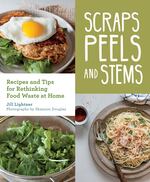To fight exorbitant everyday food waste, you’ll have to break free of beloved culinary doctrines and embrace heresy. That could be way more fun than you think, thanks to a new book by Seattle food journalist Jill Lightner.

“Scraps, Peels and Stems” includes plenty of tasty, budget-friendly recipes. But the “Aha!” moments are the author’s insights, strategies, tips and techniques to help you manage food waste in daily life, at home and out in the world.
Courtesy of Skipstone
"It's such a modern, a very West Coast sensibility to just only and always buy fresh," said Lightner, author of "Scraps, Peels and Stems: Recipes and Tips for Rethinking Food Waste at Home" from nonprofit Skipstone in Seattle. "Buy fresh" is one of the assumptions she takes on in her strategy-studded guide to avoiding food waste at home and out in the world.
“Scraps” is the opposite of strident. Its inconvenient truths are delivered amid appealing recipes and practical, realistic advice. Home-kitchen topics include meal-planning and freestyle cooking; food shopping, prep, composting/recycling and storage; and portioning and dealing with leftovers. Her bold ideas for navigating restaurants address waste on the plate and preventing its creation at all.
The single most significant step you can take at home is to master a couple of main dishes that you can adapt to whatever you have on hand, Lightner said. “And then get comfortable tweaking any recipe with those ingredients you already know. It just takes so much of the stress out of that daily dinnertime grind.”
“Food waste reduction comes down to permanently changing our habits,” she said.
What Food Waste Means
The statistics are cringe-worthy: high-income nations like the United States waste about 40 percent of their food late in the supply chain, thrown away by retailers, restaurants and consumers. That’s nearly 20 pounds per month per American, Lightner reports.
Beyond the food itself, we lose water, possibly fertilizers, labor — and calories needed by the hungry. “If we can reclaim 25 percent globally of what’s wasted every year, we can feed an additional 870 million people,” she said.
All-you-can-eat buffets at hotels, casinos, cruise ships, restaurants, and cafeterias are an example of waste on a humongous scale. To “think globally, act locally,” nonprofit gleaning organizations help bridge the gap between the overfed and the hungry in many cities.
Urban Gleaners in Portland, Oregon, regularly collects surplus fresh prepared foods from metro-area restaurants, grocery stores, event sites, college and corporate campuses and other resources. It quickly sorts and repackages items and distributes family-sized portions to those in need, through schools, mobile markets and hunger-services organizations.

As part of its Rescued Foods series, Portland ice cream scoopery Salt & Straw collaborated with Urban Gleaners to create the limited-edition flavor Toasted Baguette PB&J. In addition to rescued baguettes, berries from the nonprofit’s freezer were incorporated.
Courtesy of Salt & Straw
To make a difference, Lightner suggests starting "with something small, like 'I'm going to stop wasting food and … stretch my food dollars and, in turn, find a few bucks every month to give my food bank, or to supply it with fresh ingredients that I grow in my garden for free.' "
At home, cutting food waste starts with meal-planning, based on what's on hand ("first in, first out") and a thoughtful shopping list. "Just learn to think about your pantry and your fridge as handy as the grocery store deli, because you've stuffed them with stuff that lasts a long time and is pretty good to eat, both tastewise and nutritionwise," said Lightner.
Even if you avail yourself of resources like farmers’ markets, CSA boxes, animal shares or meal kits, you’ll likely still shop at the grocery store. Lightner recommends twice weekly and only with your list. And she’s pushing you to the freezer cases.
Out In The World
If customers say no to food before it arrives on plates, restaurants will stop buying and serving it, says Lightner, reducing waste higher on the chain. Here are additional tips when eating out.
Downsize your meal. Share the fries or skip the combo. Say no to the chips or side salad. Ask "is it possible to order a half portion? If not, can you pack half my meal to go rather than put it on my plate?"
Hold the raw veggies, like that pallid, out-of-season tomato slice, condiments or garnish.
Take home your leftovers. Leftovers often do better turned into a different meal rather than simply reheated, writes Lightner in the book. "A couple basics: toss leftover vegetables into eggs for a frittata; slice up leftover chicken, pork chops, or steak to top a salad; or roll up almost anything in a tortilla with some cheese and a scrambled egg for a never-the-same-twice breakfast burrito." With a few additions, a leftover turkey avocado club sandwich becomes a casserole. (Earn points for bringing your own superior container, or repackage when you get home.)
The Surprising Case For Frozen
Seafood is extraordinarily perishable when fresh, Lightner says, but “people give me such a stink-eye when I talk about buying it frozen.” She warns shoppers not to mistake beautifully displayed, previously frozen fish for fresh; “slacking out” is the industry term for letting fish thaw to enhance visual appeal.
“The freezing technology has just improved so well across the board in the modern century,” she said. Frozen immediately at the source as far away as Alaska, Thailand and Chile, fish is shipped even to West Coast cities with reputations for great local seafood. Delicate fish protein is easily damaged by changes in temperature but “if it stays hard-frozen until 30 minutes before you're ready to use it, it's going to be beautiful.”
Her case for unseasoned produce is similar. Food is “picked right when it's ripe and frozen immediately and you retain a surprising amount of the nutritional benefit,” said Lightner. "Whereas if you buy something fresh and then it sits in your refrigerator for a week,” it loses value and appeal — and you might toss it entirely.
Consider the texture of what you’re making, she suggests. “If you want it crispy or roasted, whether that's cauliflower or carrots or broccoli, start with fresh. But if it's going into a softer satay or soup — or just seasoned really well and served as a side — frozen is such a great option.” Her other favorites include peas and leafy greens like spinach.
The Storage Switch-up
Do you know which perishable pantry staples are fine stored in the cupboard and which will last longer at lower temperatures? The prospect of clearing space in the refrigerator and freezer for brown rice, whole grains, whole wheat pasta and maple syrup might not be that daunting. Also consider rearranging the kitchen to store nonperishables away from light and heat.
Other smart storage advice: Understand product date stamps but then train yourself to disregard them and trust your senses; invest in clear, airtight (leakproof) containers of different sizes; identify and date everything using masking tape and a permanent marker; commit to repackaging produce at home to prolong its freshness.

In this easy chili, use up cooked meat you have on hand. Jill Lightner’s suggestions include rotisserie chicken; sliced, chopped ham; leftover roast turkey; leftover Porterhouse steak cut into bits and frozen; or smoked turkey leg (you used half in a sandwich and stashed the rest in the freezer for just this opportunity).
Shannon Douglas
Chili
"Most writing about chili is devoted to exploring specific styles and techniques, along with hinting at secret ingredients — which makes it seem that chili is America’s cassoulet and it’s only a matter of time before a recipe for it appears that demands $100 in ingredients and a day off work just to shop. Classic Texas chili is simple and beefy, essentially braised beef and red chilies; elsewhere, including here, chili tends to involve ground meat, beans, and tomatoes along with chili powder or perhaps some fresh chilies. I prefer chilies in adobo, as their texture melts nicely and the leftovers from the can freeze well.
"Overall, I’d give this chili a three-and-a-half- to four-star heat rating; using fewer chilies or skipping the cayenne will reduce it. Use the larger amounts of beans and chilies if you want to feed a crowd; this recipe is very forgiving and can easily be expanded." — Jill Lightner
Less than an hour start to finish | Easy
6 to 10 servings
Ingredients
- 1 pound ground meat (turkey, beef, pork, Mexican chorizo, Italian sausage, or a mix of any of these)
- 1 medium white or yellow onion, diced
- 1 medium carrot, peeled and diced
- 3 cloves garlic, minced
- 1 to 3 chilies in adobo or to taste, chopped
- 1 tablespoon chili powder
- 1-1/4 teaspoons salt
- 1 teaspoon ground cumin
- 1 teaspoon freshly ground black pepper
- 1 teaspoon ground chipotle or smoked paprika
- 1/2 teaspoon instant coffee (optional)
- 1/4 teaspoon cayenne pepper, or to taste
- 1 (15-ounce) can diced tomatoes
- 1 to 2 (15-ounce) cans beans, drained (pinquito, pinto, great northern, kidney, black, or a mix)
- 3 cups beef or chicken stock
- 1 to 3 cups chopped or shredded cooked meat (whatever you have on hand)
- 1 to 2 cups water
To prepare
- In a 6-quart Dutch oven set over medium-high heat, brown the ground meat, breaking it up into small pieces with a wooden spoon as it cooks, for about 5 minutes.
- Add the onion, carrot, and garlic and cook, stirring occasionally, for about 7 minutes, until the carrot is softening and the onion is translucent with light-brown edges.
- Stir in the chilies in adobo, chili powder, salt, cumin, pepper, chipotle, coffee, and cayenne and mix well to distribute the spices.
- Add the tomatoes with their juice; reduce the heat to medium-low, and cook for about 15 minutes, until the tomatoes and chilies are very soft.
- Stir in the beans, stock, and cooked meat and heat through.
- Add water as needed to thin to desired consistency, then taste and adjust the seasoning.
Serving suggestions: Top with grated cheddar or pepper jack cheese, sour cream, green onions and/or crumbled tortilla chips. Accompany with a hearty dark, leafy green salad with vinaigrette dressing. Serve with a toasty, malty lager.
Leftovers will keep in the fridge for up to 4 days or in the freezer for up to 6 months.
Copyright 2018 by Jill Lightner. Excerpted with permission from “Scraps, Peels, and Stems: Recipes and Tips for Rethinking Food Waste at Home” (Skipstone, October 2018)